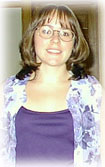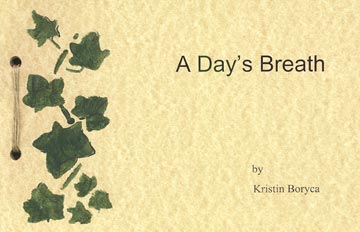|
|
 Kristin Boryca |
A Day's BreathAcknowledgementsI would like to thanks Dr. Randy Brooks for all his advising expertise and all of his hard work over the past two years. Thank you for guiding me and, often times, for pushing me. Also, I would like to thank those who helped edit my haiku: Kay Millikin, Melanie Hayes, Melissa Hayes and Gavena Dahlman. Each one of you added your fingerprint to this collection. Thank you for your time and hard work. Introduction by the AuthorFor me, haiku come as days draw breaths, sometimes slow and lazily, like yawning or blowing a bubble and sometiems quick, written with the urgency of someone who has just seen or experienced something so powerful that they need to write it down and preserve it, for whatever length of time, in a simple effort to remember what the feeling was all about. And, inevitably, the perishability of the moment takes hold, ending the reality that was captured in earnest only to be born into existence again when the haiku is acknowledged as possessing that special gift as it is shared among friends. To write haiku often times means taking the backseat. Every haiku has its day to be born, to struggle through the clumsiest of words and rise to consciousness. Each haiku seeks out its own balance of brevity and strength, emotion and objectivity, perishability and rapture. As the writer, I exist to mediate the negotiations of these issues, allowing each haiku time to unfold its own mystery. I thought that this collection would come with a set of guidelines with which to write haiku, a set of steps that I could divulge in wonder to all those who seek to experiment with this art form. However, I have no such information. There is no twelve-step program to follow, or even a simple three step one. What I do have, however, is a keen awareness of the importance of the audience. As a writer and, perhaps, as a westerner, it is often hard to realize that each haiku has its own voice, a voice that doesn't just speak to me but rather reverberates in the minds of everyone who reads it. The language is not always the same and the words don't always hold the same connotations, but the essence of the haiku speaks to everyone, and everyone hears something different. And so, at best I have a rough sectioning off of my haiku: four categories divided in reference to the range of emotion and influence they possess. One end of the spectrum consists of haiku that hold an intense amount of emotion that is generally universal in nature while the opposite end of the spectrum carries haiku where the amount of emotion it possesses is totally dependant on the reader. Universal Emotion Social Personal Objective It then becomes imperative to understand that accompanying the flow of content from a highly objective state to a more personal one, then to a more social state and, finally, to a more universal is the constant shift in audience, from readers who hesitate to engage in this eastern art form for too long to readers who wish to spend countless hours considering and contemplating a single haiku, letting it whisper its very own secrets to them. It is in this way that spontaneity refers to not only the life captured in the haiku, but also the spontaneity with which a haiku comes to life in the reader's mind, resonating through their own personal experiences. It is in recognizing this sort of spontaneity that I recognize my audience, who is of wide and varied sorts. To eliminate nature in haiku, for example, means to elminate a section of readers who thrive on the existence of nature's link to life in an endless circle that is captured on rare occasions and penciled fervently on slivers of paper. On the other hand, the elimination of nature in haiku opens up the door to westerners scared of haiku or poetry, in general, because they feel they cannot relate to it. I find that if I look carefully enough, I will see a cowering group anxious to share their histories with me if only I find the specific door to open. Thus, as each haiku struggles to breath, I open up a page to give it air without the effort it takes to dutifully put myself in or take myself out of the picture but, rather, let the situation decide which words would best define the moment. And the "something else" that is, perhaps, in the world carves itself onto the page, allowing me, at times, to rearrange the order or choose a different scene to aid it in its mission, which is, I believe, the right of the mediator to do as negotiations are in progress. And, so, the title of this collection "A Day's Breath" refers to the opening and closing of each day in its perishable nature, while at the same time positioning each haiku in a circle of its own, speaking in the same ephemeral manner, yet living much longer. The cyclic motion of the opening and closing of days is reflected in the arrangment of the haiku in an eternal pattern of morning, afternoon and night. As the days draw breath, haiku seek out their own birth, through various languages, and slilp into the ears of the readers where they whisper different things to everyone, and it is here that I must take the backseat. —Kristin Boryca • May 2001 |
|
January morning |
|
train ride home |
|
orange peels |
|
opened newspaper— |
|
mom refills their coffee . . . |
|
sunset |
|
picking berries . . . |
|
shallow creek— |
|
finally, a gas station |
|
snow drifts |
|
snowy path |
|
running
around
the
track— |
|
in
the
mug |
|
borrowed
guitar— |
|
visiting
hours |
|
below
my
window |
|
Christmas ornament— |
|
her fingerprint |
|
tree lined river . . . |
|
hair in her face |
|
raindrops on the window . . . |
|
on her shelf |
|
the steady rhythm |
|
sounds in the dark— |
|
walking to school— |
|
over coffee |
|
last patch of snow |
|
after
communion— |
|
old
oak
tree |
|
warning
my
sister
.
.
.
|
|
the remains |
|
snow covered street |
|
melting snow |
|
on the dryer |
|
is he lost? |
|
Friday night |
|
porch reading— |
|
heat lightning? |
|
summer sunset |
|
old bridge |
|
skipping home— |
|
pastel
sky |
|
apartment
buildings |
|
Fruitloops |
|
five glasses raised |
|
open window |
|
library— |
|
starless night . . . |
©2001 Kristin Boryca, Millikin University, Decatur, Illinois || all rights reserved for original author
